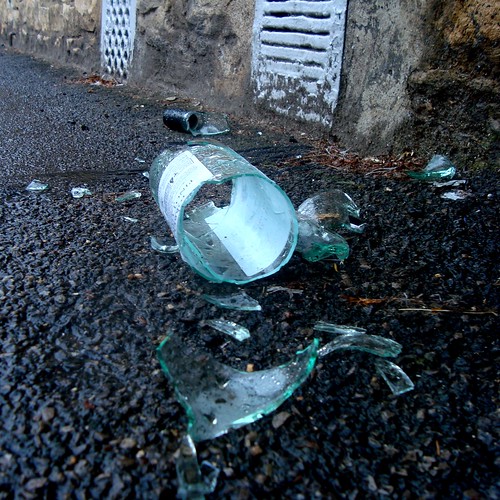Wednesday, December 28, 2011
shattered dreams
Apparently the video is playlisted on Kerrang Channel, which is great news for them, so I hope they are going to come out really big in 2012!
Monday, December 26, 2011
no trains going nowhere
And there won’t be any trains London-bound tomorrow either, nor for the rest of the week, nor next Monday in fact.
I understand that Network Rail (the one part of the railways still controlled by the government) need to do some work on the tracks from time to time, but I seem to remember from elsewhere that between major cities there are often two or more tracks running in parallel, so you can still use one while you repair the other. I also have a vague memory that other places have power cables above the lines so they can run trains with electricity and don’t have to transport all that Diesel around, and they can also reuse the brake energy. I’m wondering whether these innovations will ever reach this area …
PS: The Guardian reports that only 5 of the 25 rail companies around the country are running any service at all today. Very depressing.
Thursday, December 22, 2011
happy solstice
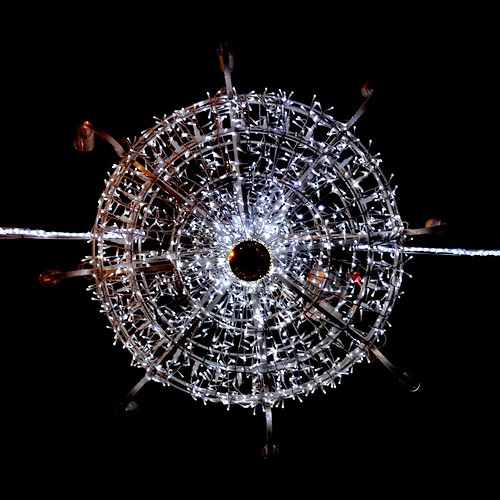
A few more seasonal pix are at the top of my flickr photostream right now.
Have a good one, and see you on the other side.
Tuesday, December 20, 2011
the right diet for me
The wine diet
Roger Corder
Sphere, 2007
I may be a bit biased, as I am very partial for a glass of Côtes du Rhone and a bit of dark (>70%) chocolate, so any book that tells me these two are good for me already has one bonus point. On the other hand, I’m not much of a foodie and wouldn’t normally dream of buying a book that has “diet” in the title, so I guess that cancels out.
My lifestyle choices and agreement with the author’s opinion apart, this is an interesting blend of popular science writing and nutrition advice including recipes, all informed by the author’s own research into the effects that one group of chemicals found in red wine and fruit has on the lining of our blood vessels and hence on the health of our heart and circulation.
The short message is that oligomeric procyanidins (and not the more widely known resveratrol) are the likely cause of the “French” paradox, namely the unusually long life expectancy of people in Southern France and other places where a Mediterranean lifestyle is cultivated (Sardinia is the place to be, apparently, if you want to live to 100!). These polyphenols are present in certain red wines (especially in those produced following more traditional procedures), as well as in fruit and berries including cranberries, pomegranate, and raspberries. As these molecules have an adstringent effect as well, modern food processing methods tend to do what they can to remove or destroy them.
The author is very eloquent at explaining what - according to recent research from his lab and others - is good for us, and manages to debunk some “voodoo science” along the way, including the excessive cult of antioxidants. Very interesting read – obviously even more satisfactory if you happen to like the kind of food he recommends.

Saturday, December 17, 2011
ten fatal flaws of the financial markets
1. The trillions circulating in the parallel universe of complex finance products (exceeding the turnover of the real world economy of goods and services by more than an order of magnitude) tend to multiply in ways that produce speculative bubbles.
2. These funds go looking for returns that would be unrealistic in the real world markets, thus sucking more and more money out of the real markets into the parallel world.
3. Banks keep inventing new finance products which tend to be opaque and often carry high risks.
4. Banks operate with insufficient levels of own (real world) funds.
5. Financial markets are intransparent and their risks unknown.
6. Concentration in these markets has produced mega banks that are too big to fail and thus a risk to the whole system.
7. Computerised trading encourages herding effects which lead to positive feedback loops, hence, disaster.
8. Interconnectedness of financial markets via derivatives synchronises them, another positive feedback loop that puts oil on the fire of any crisis in one market.
9. Financial markets resist attempts at regulation or supervision, evading into even more opaque systems.
10. Financial markets undermine conventional market economy and democracy.
The article concludes that of these 10 “monstrous” dangers, the G20 countries are currently addressing a grand total of 2, namely No. 5 transparency and No. 4 the minimum capital of banks. (Well done to our politicians – even I as a complete lay person in all things financial was aware of at least three of these! OK, only since I wrote the feature on food speculation this summer).
Now I’m really scared.
I’m beginning to realise that anything we do down here in the real world will have no effect whatsoever on this monster that’s probably going to eat us some time soon. Somebody should develop a clever algorithm that stops all these problems, for instance by introducing negative feedback and punishing herding behaviour. Trouble is, most of the people clever enough to do this are bound to be very busy making the problems worse.

The €ye of the storm ... European Central Bank in Frankfurt.
Friday, December 09, 2011
burning questions
* how many lab procedures can fit on one microchip?
* which type of pluripotent cells will enable regenerative medicine to take off?
* who needs an electronically controlled Bunsen burner with menus and joystick?
Specifically:
Organische Synthese: Alles auf einem Chip
Chemie in unserer Zeit 2011, 45, 370.
Blickpunkt Biowissenschaften: Drei Optionen für die Ersatzteilmedizin
Nachrichten aus der Chemie 2011, 59, 1160.
Ausgeforscht: Vom Bunsenbrenner zum iBrenn
Nachrichten aus der Chemie 2011, 59, 1138.

Image Source: Wikipedia
Wednesday, December 07, 2011
live from paris - review
This is Shakira’s fourth live DVD, so you may wonder whether she can add something new to the series, but as someone who knows the first three by heart I can reassure you that the new offering is a combination of the reassuringly familiar with the new and inventive.
Very familiar and mostly unchanged are the songs at the hard core of her repertoire from the 90s albums Pies descalzos and Donde estan los ladrones. As far as I can tell, she hasn’t changed a note in her own favourite, Inevitable, since the MTV unplugged concert, and Si te vas, and Ciega sordomuda are similarly steadfast reminders of the good old days.
A lovely new feature is the medley made of A'tini al-Nay (an Arabic song she used to sing as a child), the Metallica cover Nothing else matters, and her own Despedida from the Love in the times of cholera soundtrack. Travel around the world in just a few minutes. Within the same “acoustic” setting is a much-improved version of Gipsy.
Since I saw the show at Paris in December 2010, she added a lovely French song (Je l’aime a mourir by Francis Cabrel) and switched a few more of her announcements to French, which is a nice touch. My only moan about the programme is that none of the collaborators showed up (while Alejandro Sanz and Wyclef Jean did, the last time round).
The DVD with 99 minutes of concert footage and 20 mins “behind the scenes” extras is perfect as always. The CD contains as much of the concert as fits on a single audio CD (big improvement on the 5-track CD from last time!), which means all announcements and a couple of songs (Si te vas, Gordita) were dropped, and the A'tini al-Nay snippet was cut too. The sound editing on the CD is different from the DVD version; there were a couple of places where I think I heard things that weren’t so prominent in the DVD soundtrack.
Her last words on the concert recordings are “a la prochaine” (until the next time), so I’m very much looking forward to the next tour and the 5th DVD. After New York, Rotterdam, Miami, and Paris, maybe we'll hear her "live from Beirut" in four years time, complete with a full-length version of A'tini al-Nay?

(Cover of the DVD+CD pack, which comes in a CD case)
amazon.co.uk
Tuesday, December 06, 2011
mind your mouse brain
Small brain, big science
Current Biology, Volume 21, Issue 23, R935-R937, 6 December 2011
FREE access to PDF file
Monday, December 05, 2011
sticky stuff
Getting stuck in
Chemistry World 8, no. 12, pp 52-55
restricted access
Wednesday, November 30, 2011
inverted moons
I should just add that one doesn't need to know about waning moons and what time they rise - it is completely sufficient to know that both Sun and Moon move from left to right in the sky (seen from the Northern hemisphere outside the tropics) and that the bright side of the moon points towards where the Sun is. So in the wrong xmas card, the bright side points to the left, so the Sun is trailing the Moon and will rise in a couple of hours, so it must be early morning. For an evening scene, you want a Sun that has recently set, so bright side of the Moon must point to the right. Simples.
Are these artists the same people who insist on putting inverted helices on the covers of books and magazines, I wonder ...
Tuesday, November 22, 2011
dancing about science
Dances with magpies
Current Biology, Volume 21, Issue 22, R905-R907, 22 November 2011
doi:10.1016/j.cub.2011.11.008
Summary and free access to PDF file

A European magpie (source)
Rambert Dance Company
Thursday, November 10, 2011
water world
Sex, drugs and seaslime: the oceans’ oddest creatures and why they matter
by Ellen Prager
University of Chicago Press 2011
has appeared in Chemistry & Industry, issue 21, page 27 (restricted access)
Here's a snippet:
[...] as a taster of the overwhelming biological diversity that is out there in the oceans, the book is certainly a stimulating read. Given the amount of slimy, shapeshifting, limb-regenerating, and deadly poisonous weirdness found in its pages, it is intriguing to think about what we may still be missing in those 91 % of marine species that remain to be discovered.

Tuesday, November 08, 2011
Neanderthals old and new
I never went back to the cave and lost contact with the research team in the following years. Imagine my surprise then, as I researched an article on modern (genomic, imaging, etc.) methods of research into Neanderthals and found out that in the years 2005-2008, the very cutting where we had scraped around for a week had yielded skeletons with articulated parts of three Neanderthal individuals, found in an arrangement that suggests they may have been buried ritually (with their hands close to their heads, as has also been observed in other Neanderthal graves).
Given the slow progress of the excavation, which is carried out only during the summer months, we must have been less than a metre away from those skeletons. While there have been similar finds further north in Europe, this burial site is a first for the Mediterranean coast, and it may allow comparative studies re. how Neanderthals lived under different climate conditions. Sadly, however, attempts to retrieve DNA from the Spanish Neanderthals have remained fruitless. It appears that the genetic material doesn’t survive very well in the hot climate of southern Spain.
The discovery and excavation of the three skeletons is described in great detail in
M. J. Walker et al., Quaternary International 2011 (in press), doi:10.1016/j.quaint.2011.03.034
As the cleaning and detailed characterisation of each skeleton proceeds, individual studies will also become available. The first one appeared in September in PNAS:
M. J. Walker et al., Proc. Natl. Acad. Sci. USA 2011, 108, 10087
Oh, and my news feature on how genomics, imaging etc. is revolutionising palaeoanthropology is out in Current Biology today:
Virtual Neanderthals
Current Biology, Volume 21, Issue 21, R871-R873, 8 November 2011
doi:10.1016/j.cub.2011.10.031
Abstract and FREE access to PDF file
Thursday, November 03, 2011
Shakira live from Paris
As the UK distribution is hopeless again (amazon.co.uk offers the DVD for an astronomical price of £ 26.75 and doesn't give a date when it might be available!), I've ordered my copy from amazon.de.

Oh, and there is a new live video out to promote the DVD, it's Antes de las seis from the Sale el Sol album. One of my favourite songs.
Saturday, October 29, 2011
dying stars
From dying stars to the birth of life
by Jerry L. Cranford, Nottingham University Press
which is an attempt to popularise astrobiology. I can't really recommend the book, for the reasons outlined in my review, so I'll just politely fall silent here ...
Wednesday, October 26, 2011
tintin revisited
many thanks for offering your 3D, motion captured, animatronic, and everything else take on the Tintin stories, but I'm afraid I've decided to stick with the original:
This edition of "Le secret de la licorne" (the secret of the Unicorn) is even older than me, not dated, but from the list of other Tintin adventures on the back, it must have been printed between 1960 and 1963.
For some deeper insights into the Tintin oeuvre, see the brilliant book Tintin and the secret of literature by Tom McCarthy, which I reviewed here.
PS: Further reasons not to watch the film:
why the CGI doesn't work and only produces zombie impressions (interesting in that it tells us how our brains process people images differently from everything else!)
Tom McCarthy on how Spielberg missed all the interesting bits in Tintin
Peter Bradshaw's review of the film
Nicholas Lezard trying to cope with the trauma the film inflicted on him
PPS Art critic Jonathan Jones tries to mediate between Tintin fans and those who appear to like the movie.
Tuesday, October 25, 2011
illuminating brain function
Stanford researcher and practicing psychiatrist Karl Deisseroth, who invented the method and pioneered its use, is keen to apply it directly to psychiatric questions. Others think a few fundamental things need to be sorted out first. Read more about all this in my feature, which is out in today's issue of Current Biology:
Shining new light on the brain
Current Biology, Volume 21, Issue 20, R831-R833, 25 October 2011
doi:10.1016/j.cub.2011.10.007
Summary and free access to PDF file
Thursday, October 13, 2011
walking with molecules
Researchers have been able to build synthetic walkers from DNA for a few years now, and recently have also introduced the first small molecule walker that matches the key criteria of the walking molecules in the cell.
I wrote a feature about all this which is out in Chemistry & Industry this week:
Walking in the nanoworld
Chemistry & Industry issue 19, pp 20-22
free access to full text (html)

A couple of macroscale walkers appear on the cover of the issue by coincidence.
Tuesday, October 11, 2011
don't play with food
For more info about this scandalous situation (and some of the science behind it, including, again, herding), read my feature in today's issue of Current Biology:
Don't play with food
Current Biology, Volume 21, Issue 19, pages R795-R798, 11 October 2011
doi:10.1016/j.cub.2011.09.037
summary and free access to pdf file
On the same issue, the World Development Movement (also mentioned in my feature) have today issued a press release:
450 economists call on G20 finance ministers to stop speculation fuelling hunger
Thursday, October 06, 2011
October crop
Die Energie der Mitochondrien und ein bewegtes Forscherleben, Spektrum der Wissenschaft 2011, Nr 10, 100. (review of "Feuersucher" by Gottfried Schatz)
RNA-Gerüst bringt Ordnung in die Zelle, Chemie in unserer Zeit 2011, 45, 351
restricted access to PDF file
Ungestörtes Wachstum erwünscht, Nachrichten aus der Chemie 2011, 59,966
Eine schräge Geschichte, Nachrichten aus der Chemie 2011, 59, 936
Erlenmeyer's original design drawing, apparently. Source: wikipedia
Tuesday, September 27, 2011
when, where, and why people riot
My feature about all this is out in Current Biology today:
Why do people riot?
Current Biology, Volume 21, Issue 18, R673-R676, 27 September 2011
doi:10.1016/j.cub.2011.09.015
FREE access to full text and pdf file
PS: Results of the detailed study of the 2011 riots are published here.
Tuesday, September 13, 2011
food fight
Chemical crop protection is under attack from all sides, as GM crops push some of it out of the global market (though not the European one, where people mistrust GM), resistance to established herbicides is spreading, and the fears of side effects (most recently: on bees) aren't going away either.
So I've looked into what direction the industry may take to get out of this trouble, and found a few interesting new approaches.
Read my feature in today's issue of Current Biology:
New directions in crop protection
Current Biology, Volume 21, Issue 17, R641-R643, 13 September 2011
doi:10.1016/j.cub.2011.08.055
Summary and limited access to PDF file
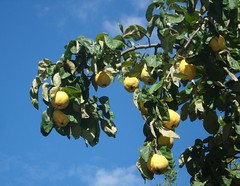
Don't know what they fed this quince tree (not mine)!
Monday, September 12, 2011
book projects
Meanwhile, the completely revised and updated second edition of Astrobiology: a brief introduction is available around the world now, so get your copy to find out everything you always wanted to know about Life and the Universe. (Note that the hardback is made for library use and therefore doesn't have a dustjacket, so it's just plain black and you don't get the lovely cover design.)
Thursday, September 01, 2011
budapest globalised

Add to that the German-built cars that block the roads (traffic is a bit of a nightmare on the main routes through the city, but amazingly, drivers very willingly stop to let pedestrians cross), and you'll come to the conclusion that the profits of virtually every economic activity that goes on around there (with the possible exception of haircuts) will be skimmed off by somebody in the west. Oh well.
Funny that after 18 years in the UK, finding the German logos in Hungary is just mildly amusing. It's the Tesco branches, ranging from "expressz" to "hipermarket" that really annoyed me. From our experience here we know that these spread like Japanese knotweed.

Saturday, August 27, 2011
budapest's red trolleybuses

They kept reminding me of a lovely song by Bulat Okudzhava (1924-1997):
I actually saw Okudzhava playing live many years ago, when we lived in Regensburg. I knew his work as I was learning Russian at the time. There was a cultural centre on the opposite side of the square where we lived and one day I just walked past the door of that centre and spotted a plain A4 sheet of paper taped to the door, saying Bulat Okudzhava will be playing here on (date, time), which happened to be the day after I saw the notice. That was the only announcement there was, and accordingly it was a very intimate event. I seem to remember there was a translator who read out German versions of the lyrics before each song.
Well, anyhow, more about Budapest to follow.
Friday, August 26, 2011
Almodóvar’s Frankenstein
I guess the quickest way to define this film is “Almodóvar’s take on Frankenstein,” although it is loosely based on a different book, a novel by Thierry Jonquet. As I’ve seen a dozen of Almodóvar’s movies, most of them more than once, but zero Frankenstein movies, I’m coming to this junction from a different angle than most people in the English speaking world. So here are some thoughts on how the film fits in with the work of San Pedro (I unilaterally elevated him to sainthood in a previous blog entry, these catholics are sometimes too slow in recognising achievement).
The movie is in fact, Almodóvar through and through, in every part of it there are aspects that are familiar, from the medical / bioethical issues through to he (trans)gender, rape, and sexual identity themes. As these are natural parts of the story, they don’t feel like the auteur is quoting himself – it just amazes me every time that he can assemble a completely different story from what at first glance might appear to be the same building blocks. (Which strikes me especially as I don’t necessarily share his obsession with these recurring themes, and yet they win me over every time.)
There is one interlude where Almodóvar is in fact shamelessly citing himself and contrasting the shrill style of his early work with the mellower style he has adopted since “All about my mother.” It’s the sequence that features a man in a tiger carnival costume and references Kika among other early works. The tiger aside, the rest is all in very mature taste - just savour the interior decorations, worlds away from the women on the verge of a nervous breakdown, although everybody in this movie has good reasons to be on the verge of that or worse.
For fans of the early work it is, of course, a major occasion to welcome back Antonio Banderas, who last appeared in Women on the verge and in Tie me up, tie me down! I prefer not to think of what he did in those 21 years in between (am very busy erasing those spy kids movies from my memory), but it is good to have him back, even if he looks ten times older than the last time. He looks a bit like Sean Connery from some angles, maybe Almodóvar and Banderas should do a Bond movie together, now that would be interesting!
Another familiar face (for the aficionados of Spanish cinema, at least) is the female lead Elena Anaya, who had a supporting role in Julio Medem’s Sex and Lucia and a lead role in Room in Rome (and a small role in Talk to her, apparently, will have to watch that one again to find her). And we welcome back Marisa Paredes who starred in All about my mother and Flower of my secret.
The Frankenstein-esque story is interesting too, of course, not least because of all the bioethical dilemmas that we also have to confront here in the real world, but that wouldn’t necessarily have convinced me to watch the movie if it had arrived from somewhere else. It’s the way San Pedro does it. He could make a movie out of the phone directory of Madrid and I’m sure it would still be fascinating.
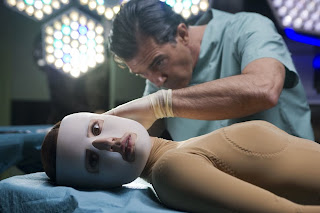
The skin I live in is on general UK-wide release from today (I was lucky to catch a preview last night). Full details at IMDB.
Peter Bradshaw's review in the Guardian (his second take, as he already reviewed it when it was shown at Cannes).
Thursday, August 25, 2011
walking in Vienna
Clearly, the city turned its back on the river, and the idea that anyone might walk down to the river never occurred to anybody involved with its planning. Parallel to the river on the city side there is a little used railway line, but to cross it there are only the motorway bridges crossing over the river as well. Walking along the rail line, we eventually found an old station with a level crossing where we could sneak through and on to the river bank. Which was, of course, blocked up entirely with several Titanic-sized cruise ships.
The city’s other river, the Wien, is also disappointing, as it is completely walled in (see photo, left) and over long stretches even covered up.
A bit of a history lesson, we saw the spectacular Flakturm in the Augarten, and the one in Esterhazy Park, which hosts an aquarium/terrarium. These WWII upright bunkers with walls 5 metres thick are apparently so strong that it wasn’t economically feasible to demolish them, so they are still sitting around. The Lonely Planet guide of Vienna offers a half-page explanation of these monstrosities, while the German Baedeker chooses to ignore them, a case of “Don’t mention the war”?
On the Northeast side of the Burggarten there is a tropical greenhouse specially for exotic butterflies, the Schmetterlingshaus:
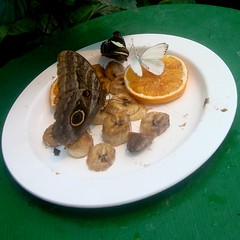
More photos
Tuesday, August 23, 2011
synthesising life
 I've always been puzzled by the field of synthetic biology. Every now and again, I write a piece about it in a bid to understand what it really is about. My latest attempt at understanding is out today in Current Biology:
I've always been puzzled by the field of synthetic biology. Every now and again, I write a piece about it in a bid to understand what it really is about. My latest attempt at understanding is out today in Current Biology:
What exactly is synthetic biology?
Current Biology, Volume 21, Issue 16, R611-R614, 23 August 2011
doi:10.1016/j.cub.2011.08.002
abstract and FREE access to pdf file
As always, I have used examples of recent research to try and define the field, but surely, I will need a few more articles to sort this out.
Image source: wikimedia commons
Friday, August 19, 2011
Frankfurt
We stayed at a hotel close to the European Central Bank, so were close to one of the epicentres of world events when the markets took a nosedive on Monday 8.8. Didn't notice any suspicious activity in the banking quarter of the city, but then again we were busy dodging the torrential showers that swept by in half-hour intervals.
Only in the evening, watching CNN in the hotel room with the Dow Jones shown in a corner of the screen and losing dozens of points every few seconds, did we find out there was trouble.
So here's the peaceful scene outside the ECB after the markets closed:

Banks aside, Frankfurt also has a very lovely promenade where you can walk (or jog, cycle, rollerskate) along the river Main for miles. Such an obvious boost to quality of life, but not all cities get it right.
Additional photos from F. in my flickr set Germany, and further riverside adventures to follow ...
Thursday, August 18, 2011
autistic genomes
I've written a feature article about all this which is in the latest issue of Current Biology:
Copy numbers count for autism
Current Biology, Volume 21, Issue 15, R571-R573, 9 August 2011
doi:10.1016/j.cub.2011.07.031
abstract and FREE access to pdf file
Wednesday, August 17, 2011
rocks falling from the sky
Chemistry of the solar system
Katharina Lodders and Bruce Fegley, Jr.
RSC Publishing 2011
ISBN 978-0-85404-128-2
is out in Chemistry & Industry issue 15, p26
I'm afraid it's premium content but do let me know if you need a copy.
I've been rather critical of the book, I'm afraid, but here's a snippet from my review about the chapter on meteorites, which was the part of the book I liked best:
"Meteorites also cast an interesting light on the history of the scientific revolution. Many of the first scientists in the modern sense rejected the idea of rocks falling from the sky as a medieval superstition. Enlightened modernists at the end of the 18th century evicted meteorites from museum collection. Only in 1794 did a brave soul start building the case for their extraterrestrial origin, which gradually won the day."
Saturday, August 06, 2011
phages and pili
Planet der Phagen
Spektrum der Wissenschaft August 2011, page
Wie die Haare der Bakterien wachsen
Chemie in unserer Zeit 45, No. 4, page 234
DOI: 10.1002/ciuz.201190057
abstract and limited access to PDF file
a chestnut tree, as featured in the phages work reported
Wednesday, August 03, 2011
a poisonous surprise

Oxford Zoologist Fritz Vollrath is famous for his work on spiders, but sometimes his team also gets involved in finding out amazing things about larger animals, such as rats storing poison in their fur. They have a paper out today, here's an excerpt from the press info:
For many years mystery has surrounded the sudden collapse, sometimes followed by death, usually at night, of dogs in north-eastern Africa. Typically, if the dogs do not die at once, they lose co-ordination, froth at the mouth and show symptoms of acute distress. In some rural areas elders or hunters might identify a wooly grey rodent as the culprit and warn that the rat is extremely poisonous. New research has confirmed that warning.
The Crested Rat, Lophiomys imhausi, 40-50 cm. long, looks quite innocuous as it clambers about in rocky, wooded valleys in Kenya and the Horn of Africa. If disturbed the long fur on its flanks parts to expose a vivid black and white pattern around a leaf-shaped tract of peculiarly specialized hair. Just how specialized the hair is and how well designed each hair is to hold and dispense poison has been revealed by a group of East African and Oxford scientists.
The group have identified the toxin, which comes from Poison-arrow trees of the genus Acokanthera, long celebrated for an extract from their bark and roots which, when applied to an arrow-head, can fell an elephant.
The scientists have observed the rat gnaw Poison-arrow tree bark directly from the plant, chew it and then deliberately slather the resulting colloid onto the flank hairs. These hairs are designed to rapidly absorb the colloid, acting like a lamp wick. The poison,Ouabain, is well-known as a heart-stopping cardiac glycoside and for centuries doctors have used minute doses of Ouabain to stimulate weak hearts.
The Crested Rat is the only mammal known to sequester plant toxins in this way. When more is known about the chemistry and genetics of the Crested Rat’s immunity to and use of Ouabain there may well be applications for human medical therapies.
In 1974 the senior author, East African Jonathan Kingdon, first advertised the mystery of a poisonous rat and invited further study. It has taken nearly 40 years for the mystery to begin to be solved.
A poisonous surprise under the coat of the African Crested Rat.
Jonathan Kingdon, Bernard Agwanda, Margaret Kinnaird, Timothy O’Brien, Christopher Holland, Thomas Gheysens, Maxime Boulet-Audet and Fritz Vollrath
Proc. R. Soc. B published online before print August 3, 2011, doi:10.1098/rspb.2011.1169
full text (open access)
Monday, August 01, 2011
anarchy in the proteome
Anarchy in the proteome
15 years ago, the idea that proteins might be functional without a well-ordered 3D structure was heretical. But Michael Gross discovers, a little flexibility can go a long way
Chemistry World August 2011, pp 42-45
FREE access to PDF file
The field has certainly grown amazingly in the 14 years since I first wrote about it ...
Among other illustrations, the article features a photo from Stacey Raven, which I accidentally discovered on flickr:

Wednesday, July 27, 2011
inspirational diatoms
It appears to be freely accessible here - you just have to click on the sub-headings to get the next part of the text.

Photo: Wipeter, Wikimedia Commons
Tuesday, July 26, 2011
nature's value
It was all about how we may still be able to avoid blowing up our planet if we get businesses to recognise the value of the natural resources they are using, polluting, or destroying with their activities.
Personally, I would prefer if people could just do the right thing because it is the right thing to do, and wouldn’t need price tags and bribes to steer them in the right direction. But as we do live in a society where money talks, and which isn’t going to change any time soon, I guess the ecosystem services idea may well be our best chance for saving what's left of our natural environment.
As this is all very topical and important, I wrote a feature about what I learned at the Forum, which is out in Current Biology today:
Valuing Nature
Current Biology, Volume 21, Issue 14, R525-R527, 26 July 2011
doi:10.1016/j.cub.2011.07.003
FREE access to full text and pdf file
Oh, and I especially enjoyed Sandra Bessudo's talk (in Spanish) on the natural wealth of Colombia, and what should be done to protect it, so here's a picture of her:
This is my own photo, but there are lots of official photos from the event at the Smith School of Enterprise and the Environment's photostream.
Saturday, July 23, 2011
Common Hogweed (Heracleum sphondylium)?


Young leaves look like this:
I now think it's Common Hogweed - also see the German Wikipedia entry which has better pictures - according to those, all details seem to match. But all expert botanist advice welcome.
Oh, and I'm also clueless about the insects that often crawl around on it, as in the photo above, but the plant is more important as my son is obsessed with it and I was worried that it might be poisonous (I found half a dozen similar looking plants that are poisonous, in fact).
Wednesday, July 13, 2011
sustainable chemistry
Chemistry for sustainable technologies: A foundation
by Neil Winterton
is out in this week's Chemistry & Industry, i.e. issue 13, page 28.
Here's a snippet:
Winterton developed an optional module course covering the chemical foundations of sustainable development, out of which this book evolved. The somewhat unconnected chapters still feel a bit like coming into a lecture theatre and hearing: “This week we’re going to…” And the over-used parentheses sound like professorial asides.
Each lecture / chapter covers a significant aspect of sustainable development, up to and including the importance of science for society. Each comes with full scientific detail and an extensive bibliography. This book clearly means business. It wants to be worked with and doesn’t take kindly to being read for pleasure.
Tuesday, July 12, 2011
we're all Africa
Because, you see, considering the facts that we all came from Africa at one point, sooner or later, that most of human genetic diversity is found between African populations, not between "races", and that a large part of the global disease load weighs down on Africa, it really is quite weird that the new investigation of personal genomes so blatantly followed the money rather than the scientific interest in sequencing lots of males of European descent before even beginning to include some token people of different origin (or even gender).
Obviously, I have phrased this sentiment much more diplomatically in my feature and I also report on several initiatives which aim to empower Africans to take part in the genome revolution and also to reap the medical and economic benefits from it.
My feature is out today in Current Biology:
African genomes
Current Biology, Volume 21, Issue 13, R481-R484, 12 July 2011
doi:10.1016/j.cub.2011.06.047
Summary and limited access to PDF file

Shakira performing "Waka waka: This time for Africa" at the closing ceremony of the 2010 World Cup.
Friday, July 08, 2011
not the end of the world

(I tried a couple of news agents to see whether I could get a proper photo of the papers nicely arranged, but they all had them in very unphotogenic places and arrangements.)
I have to disagree with the headline writers who seemed relish the idea that the NOTW is "the world." I think the world at large will be a lot better off without that paper, thank you very much, and rather than the end, it is hopefully going to be the beginning of a new, better world. I think this is a historic opportunity for the UK to rebuild a democracy where elections are decided by the electorate, not by Rupert M.
PS I'm also blogging and reblogging on tumblr these days - more pics, less text than here, check it out.
Monday, June 27, 2011
astrobiology - second edition
The discovery of extremophiles in the most unlikely locations here on Earth has played a large part in propping up our hopes that life may also exist elsewhere. Add to that the discovery of more than 500 extrasolar planets in just 16 years since the first one was reported, and you get a proper scientific gold rush.
Thus, our 2006 book was beginning to look out of date and there was a strong case for a new, revised and expanded edition, which we prepared over the last year or so. We have revised the entire text, added a glossary and lots of new illustrations. New discoveries are included up to and including last December’s arsenic eating bacteria. With all this, the book will be around 90 pages thicker than the first edition, but hopefully just as readable.
The cover design, which we all love, has been kept. Only the colour of the title will now be green instead of orange, so you can easily tell the second from the first edition. The new version should be available by September in the US, maybe a few weeks later in the rest of the world.

In preparation for the release, I’m also updating the astrobiology web pages, but that’s work in progress still. (At the moment the ISBN numbers and the cover are there, but the exact page number and amazon links are still missing.)
Saturday, June 25, 2011
hidden treasures

water fountains, like this one at Barcelona:

pedestrian bridges, like this one in Amiens:

and our local bumblebees, such as this one:
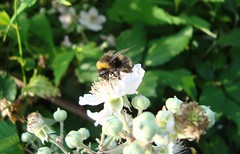
Some of the other bumblebee pictures are in double figure views only because I posted specific links on twitter - this adds 10-15 views in a minute.
But maybe I just haven't found the right flickr groups yet to promote these types of photos ? Some of the highly specific groups I'm in, specialising on windows, pedestrian bridges, fountains, etc. seem to have little effect.
Anyhow, a set of my hidden treasures is here.
Friday, June 24, 2011
suerte
As luck would have it, I just found out that Ximena has an English album in the pipeline, due to be released in August. There is already a video for the first single, Different, and I love both the song and the video (and the cuddly yellow monster, too), so even though I only meant to post the Suerte video, here comes another one ,enjoy:
so, mucha suerte to Ximena, at least in the UK she will need it.
Wednesday, June 22, 2011
flickr winner
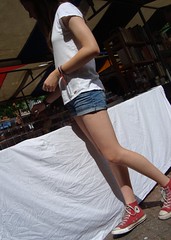
I do like the picture, of course, partially because of the composition with the female figure cutting across the white table cloth, also because I have managed to disguise the face quite cleverly. But I wouldn't have picked it for the top spot. Oh well. Some of the underappreciated gems from my photostream to follow soon.
For the complete chart countdown, click the "flickr" tag below. Alternatively, visit my flickr set more than 100 views.
Tuesday, June 21, 2011
neuroscience in China
From the epic list of addresses at the top of my thank-you email I gather that it took at least 12 kind and helpful people to help me find my way in this big topic, and during the four weeks when I kicked this around, I certainly learned a lot.
So, the result of all this is out today:
Boom time for neuroscience in China
Current Biology, Volume 21, Issue 12, R441-R444, 21 June 2011
doi:10.1016/j.cub.2011.06.001
and as it is part of some bigger event across the Cell Press journals, it is on open access here:
summary page / PDF file.
It is accompanied by a Q&A piece featuring Fang Fang (not mine, this interview was set up by the editors separately), which is also on open access.
Monday, June 20, 2011
I'm blue

This is in London, between Paddington station and Little Venice.
Sunday, June 19, 2011
summer legs (No. 3)

Saturday, June 18, 2011
jogger on the fast track

(click photo to see larger versions in flickr / click the "flickr" tag below to find other photos in my countdown)
Friday, June 17, 2011
Lady Gaga and philosophy
So, while we are all waiting with baited breath to find out what the serial philosophers will have to offer once they have woken up to the semiotic treasure trove that is the work of Gaga, I’ll start compiling a few suggestions of topics they may want to consider:
Is it music? Why Mozart might have written “Bad Romance” if he were alive today (for more about this, see here)
Is it art? The school of gagaism and its position in the development of occidental art
Baby you were born this way: The quest for sexual identity in the 21st century.
I’m in love with Judas: Gaga vs. God
Scheiße Scheiße be mine: the language and languages of gagaism
P-p-p-pokerface: The semiotics of make-up and masks
I am my hair: Hair style as a cipher for personality in postmodern society
I’m on the edge of glory: Feeding the reward system in the age of individualism
Papa paparazzi: Iconography and perceptions of fame
Monster ball: Identification and motivation of fans and followers
Gossip girl: The education of a cultural icon
All suggestions for additional chapters, and indeed authors, welcome.
I notice that Open Court have among their forthcoming titles "Rolling Stones and philosophy" (due to join a male-only club of artists like Bruce Springsteen and U2), so they are clearly catching up and might get round to the Gaga title in a few decades. My favourite title on their list of 59 books is "Woody Allen and Philosophy: You Mean My Whole Fallacy is Wrong?" (2004). The competitors at Wiley-Blackwell have Metallica as their only musical entry. Gaga apart, I really do think one of them should have covered the philosophy of Alanis Morissette by now.
Update June 2012: Open Court now list "Lady Gaga and philosophy" among their future publications, but without a date, so I'm guessing it will be 2013 before it comes out.
Update April 2015: Open Court still has it under "Forthcoming Titles: 2015 and Beyond" at the bottom of the list, now with a release date of 2017. These guys should get their priorities in order. Still no news from Blackwells.

Oh, and as bonus material, here are my random thoughts on the new album, jotted down a bit hastily after the first two or three times playing it:
Would I still enjoy this album if it had arrived in a brown cardboard sleeve and I knew nothing about the artist?
Actually, I think I would. Not all tracks are great, but there is an interesting variety and I sense the genuine artist's urge to express herself in many details. I'm not wildly excited by the first three tracks including the title track, but love the middle section starting with Judas (which I read as an attempt to recapture the glory of Bad Romance).
As someone familiar with several European languages, I find Scheiße interestingly disturbing - it mangles fragments of half a dozen languages into a meaningless but attention-catching pidgin pudding. Gets me every time. My attention tends to wander off after Bloody Mary, and come back for You and I, strangely.
Surely it's not to everybody's taste and will irritate many, but that's what art is supposed to be like. So please ignore the hype and try it with an open mind.
Thursday, June 16, 2011
cyclist, abstracted
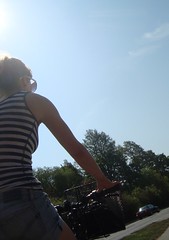
Needless to say that none of the qualities described are down to my planning. This cyclist just brushed past me on the footpath and I instinctively pushed the button.
Wednesday, June 15, 2011
Greens on course for federal government
Today's Forsa poll indicates that in response to the "Sonntagsfrage" (what would you vote if federal elections were held next Sunday?), the votes were distributed as follows:
31% CDU/CSU (conservatives)
26% Green
23% SPD (labour)
9% Linke (left)
4% FDP (liberal)
source, and additional polls from previous weeks
This would give a putative green-red coalition a solid majority, as the FDP (currently Merkel's junior partner) would fail to get into parliament, staying below the 5% threshold.
For someone who first voted in 1983, these figures just look crazy. Having been a member of the Greens from the early 80s to 2001, I never thought I'd live to see this happen.
Mind you, it's only a partially due to voters becoming greener, and a large part due to the party becoming more mainstream and normal since the days that I witnessed.
Tuesday, June 14, 2011
candid portrait

Most of my candid shots do not contain a recognisable face though - if only because we tend to have strong opinions on human faces and it is difficult to appreciate the qualities of a photo when we're busy responding to the face.
Although it has attracted more than 100 views, this photo hasn't done particularly well considering that it is in more than 25 groups, so there have been only 4 clicks per group. Anyhow, I do like it, still.
Monday, June 13, 2011
Medem medley
Saturday, June 11, 2011
flickr charts no.7

Click the image to see larger versions in flickr.
I'm counting down from 8 to 1 - use the "flickr" label below to find the other entries.
Friday, June 10, 2011
rabiosa
Oh, and the Sale el Sol tour is still going strong too, sadly I can't attend at the moment ...
Thursday, June 09, 2011
top 8 flickr pix: No. 8
Counting down the top 8 most-viewed pix, we start with No. 8, taken on a rainy evening at Lyon:

(click image to see larger versions in flickr)
This has done reasonably well thanks to the award-driven group "Photography in the Rain".
Wednesday, June 08, 2011
sticky stuff
Biological Adhesive Systems: From nature to technical applications
By Janek von Byern, Ingo Grunwald (eds.)
is in this week's issue of Chemistry & Industry (No. 11), page 27. It's premium content, I'm afraid, so only the lucky few with a subscription or institutional access can read it online here. For the rest of us, here's a snippet describing the most entertaining part of the book:
The prize for the most accessible chapter goes to the Australian frogs of the genus Notaden. Apparently these creatures are so well-rounded that they can’t cling on to each other with their short limbs during mating. Which is why they need glue, literally, in order to stick together while they are exchanging body liquids. The author tested the adhesive power of the frog secretions by sticking two full, cold and humid beer cans together, lengthwise in one experiment and bottom to top in another.

Tuesday, June 07, 2011
bees, ETs, ACGTs, and old samples
Rückkehr zum Ursprung des Lebens
Chemie in unserer Zeit Vol 45, No 3, page 158
Article first published online: 6 JUN 2011 | DOI: 10.1002/ciuz.201190041
limited access to PDF file
Genomsequenzierer. Die dritte Generation
Chemie in unserer Zeit Vol 45, No 3, pages 184–187
Article first published online: 6 JUN 2011 | DOI: 10.1002/ciuz.201100553
limited access to PDF file
most recent English article on this topic
Ausgeforscht: Und täglich grüßt E.T.
Nachrichten aus der Chemie Vol 59, No 6, page 605
Biowissenschaften: Keine Ernte ohne Bestäuber
Nachrichten aus der Chemie Vol 59, No 6, pages 629-631
most recent English article on this topic

Summary: Das Sterben ganzer Bienenvölker und der Artenschwund bei Hummeln bedrohen die Landwirtschaft in Europa und Nordamerika. Daran sind vermutlich mehrere Faktoren beteiligt, auch Pflanzenschutzmittel stehen unter Verdacht.
PS: The bees article also features my photo of a Bombus hypnorum (tree bumblebee):

(click image to see larger version in flickr)
